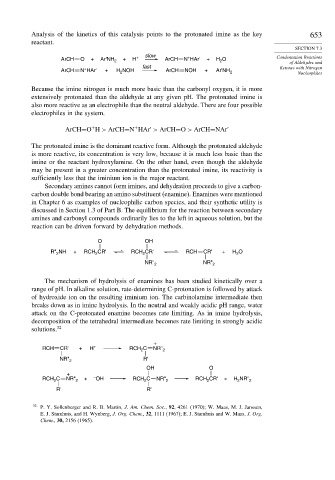Page 671 - Advanced Organic Chemistry Part A - Structure and Mechanisms, 5th ed (2007) - Carey _ Sundberg
P. 671
Analysis of the kinetics of this catalysis points to the protonated imine as the key 653
reactant.
SECTION 7.3
slow Condensation Reactions
+
ArCH O + Ar'NH + H + ArCH N HAr' + H O
2
2
of Aldehydes and
fast Ketones with Nitrogen
+
ArCH N HAr' + H 2 NOH ArCH NOH + Ar'NH 2
Nucleophiles
Because the imine nitrogen is much more basic than the carbonyl oxygen, it is more
extensively protonated than the aldehyde at any given pH. The protonated imine is
also more reactive as an electrophile than the neutral aldehyde. There are four possible
electrophiles in the system.
+
+
ArCH=O H > ArCH=N HAr' > ArCH=O > ArCH=NAr'
The protonated imine is the dominant reactive form. Although the protonated aldehyde
is more reactive, its concentration is very low, because it is much less basic than the
imine or the reactant hydroxylamine. On the other hand, even though the aldehyde
may be present in a greater concentration than the protonated imine, its reactivity is
sufficiently less that the iminium ion is the major reactant.
Secondary amines cannot form imines, and dehydration proceeds to give a carbon-
carbon double bond bearing an amino substituent (enamine). Enamines were mentioned
in Chapter 6 as examples of nucleophilic carbon species, and their synthetic utility is
discussed in Section 1.3 of Part B. The equilibrium for the reaction between secondary
amines and carbonyl compounds ordinarily lies to the left in aqueous solution, but the
reaction can be driven forward by dehydration methods.
O OH
R" NH + RCH 2 CR' RCH CR' RCH CR' + H O
2
2
2
NR" 2 NR" 2
The mechanism of hydrolysis of enamines has been studied kinetically over a
range of pH. In alkaline solution, rate-determining C-protonation is followed by attack
of hydroxide ion on the resulting iminium ion. The carbinolamine intermediate then
breaks down as in imine hydrolysis. In the neutral and weakly acidic pH range, water
attack on the C-protonated enamine becomes rate limiting. As in imine hydrolysis,
decomposition of the tetrahedral intermediate becomes rate limiting in strongly acidic
solutions. 32
+
RCH CR' + H + RCH C NR" 2
2
NR" 2 R'
OH O
+
RCH C NR" 2 + – OH RCH C NR" 2 RCH CR' + H NR" 2
2
2
2
2
R' R'
32
P. Y. Sollenberger and R. B. Martin, J. Am. Chem. Soc., 92, 4261 (1970); W. Maas, M. J. Janssen,
E. J. Stamhuis, and H. Wynberg, J. Org. Chem., 32, 1111 (1967); E. J. Stamhuis and W. Maas, J. Org.
Chem., 30, 2156 (1965).

